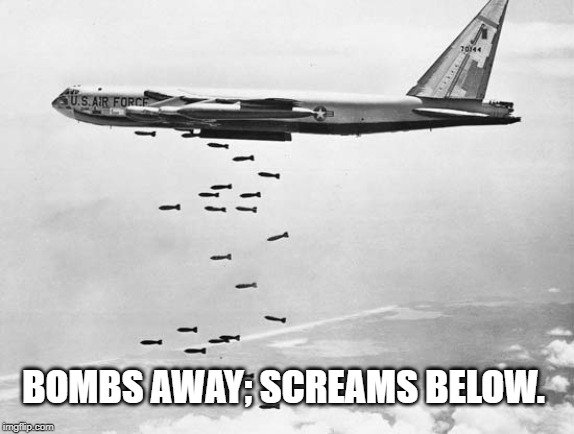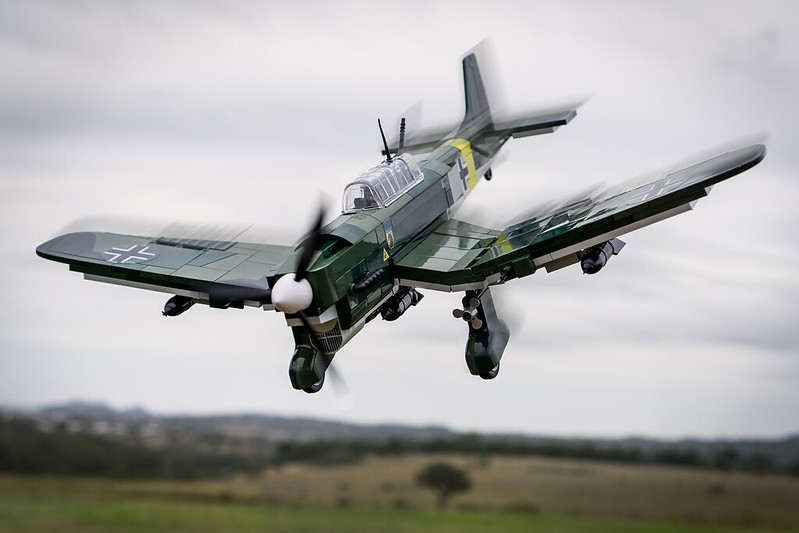Table of Contents (click to expand)
The Germans designed their bombs with a special whistle that would make that screaming cry as they fell towards the cities below. Typically, a metal object with sharp edges, like a bomb would make a small noise “hissing” sound as it fell through the air, unless it happened to exceed the sound barrier (343 meters per second), which would result in a sonic boom. However, by designing bombs that had a whistle-like attachment, the Germans were utilizing psychological warfare as much as physical warfare.
Thomas Pynchon’s masterful World War II novel, Gravity’s Rainbow, begins with one of the most memorable lines in literature—A screaming comes across the sky. It has happened before, but there is nothing to compare it to now. It is too late.
 The sound being described—that screaming—is the sound made by a V-2 rocket as it tears across the sky on its mission of destruction. Movies and television shows that deal with the wars of the 20th century often include such a whistling sound in its description or depiction of falling bombs. For those of you unfamiliar with military technology, this “whistling” may come across as strange, to say the least; in the midst of a battle, it seems unwise to give the enemy warning when dropping bombs. First of all, did that whistling actually exist, and if so, what caused it?
The sound being described—that screaming—is the sound made by a V-2 rocket as it tears across the sky on its mission of destruction. Movies and television shows that deal with the wars of the 20th century often include such a whistling sound in its description or depiction of falling bombs. For those of you unfamiliar with military technology, this “whistling” may come across as strange, to say the least; in the midst of a battle, it seems unwise to give the enemy warning when dropping bombs. First of all, did that whistling actually exist, and if so, what caused it?
The Sound Of Falling Bombs
When you are watching a Hollywood reenactment of a famous World War 2 battle, the whistling cries of falling bombs certainly help to build tension, but there is some truth behind this terrifying sound. During World War II, the Germans designed their bombs with a special whistle that would make that screaming cry as they fell towards the cities below. Typically, a metal object with sharp edges, like a bomb would make a small noise “hissing” sound as it fell through the air, unless it happened to exceed the sound barrier (343 meters per second), which would result in a sonic boom.
However, by designing bombs that had a whistle-like attachment, the Germans were utilizing psychological warfare as much as physical warfare. The whistle became associated with death from above, and since the bombing raids in London and other European cities were often done in the middle of the night, that wailing cry became a nightmare-inducing and anxiety-striking sound. Survivors of the London bombing still remember those haunting whistles of death from their underground shelters.

Some historians and soldiers argue that the whistling was intended to warn civilians of the coming danger, so they could have time to take cover or run away, but that theory falls apart when you look at the physics of such a sound. It would be nearly impossible to tell what direction the bomb was coming from by the wail alone, so it could be headed straight for you, or might land 120 yards away. Furthermore, those bomb flight times would be relatively short, so even if you did hear the wailing cry of a falling bomb, you would have very little time to react or “run away”. The whistle may have given enough warning to cover could be taken, or you could fall to the ground and cover your head, but that’s about it.
There was also a particular type of German warplane, called a Stuka, that was designed to make a piercing whistle whenever it went into a dive. This had the same effect as the falling bombs, but could last even longer, and would precede a strafing run or its own dropped payload of bombs.

Also Read: Why Does An Ambulance (Or Police) Siren Sound Different As It Passes By?
The Physics Of The Whistle
For those people who pay attention to small details, the depiction of falling bombs in Hollywood movies is usually incorrect. When the bomb was dropped and the whistling began, the pilot would hear the pitch start quite high and then reduce in pitch as he moved away from the source; this is the classic “Wheeeeeeezzzzz—–Boom!” sound effect you may have heard in movies or cartoons.
 However, that “classic” falling bomb sound is how the pilot in the plane would hear it, not the people on the ground. Quite the opposite, in fact, as the whistling bomb rapidly approached the Earth, thanks to the Doppler Effect, the whistling sound would increase in pitch, just as the wail of a police siren increases in pitch as it approaches you. In other words, the whistle would reach its highest pitch right before impacting the ground, but that is rarely how the sound effect is added to battle scenes!
However, that “classic” falling bomb sound is how the pilot in the plane would hear it, not the people on the ground. Quite the opposite, in fact, as the whistling bomb rapidly approached the Earth, thanks to the Doppler Effect, the whistling sound would increase in pitch, just as the wail of a police siren increases in pitch as it approaches you. In other words, the whistle would reach its highest pitch right before impacting the ground, but that is rarely how the sound effect is added to battle scenes!
Also Read: In An Airplane That Has Broken The Sound Barrier, Is It Completely Silent Inside The Cabin?
A Final Word
Movies and television producers don’t always get the minute details of war right, but the presence of a terrifying whistle in World War 2 movies is historically accurate. Using a combination of physical strength and psychological terror, bombs with accentuated whistles were able to do damage to the morale and psyche of the intended victims that went far beyond physical violence.
How well do you understand the article above!

